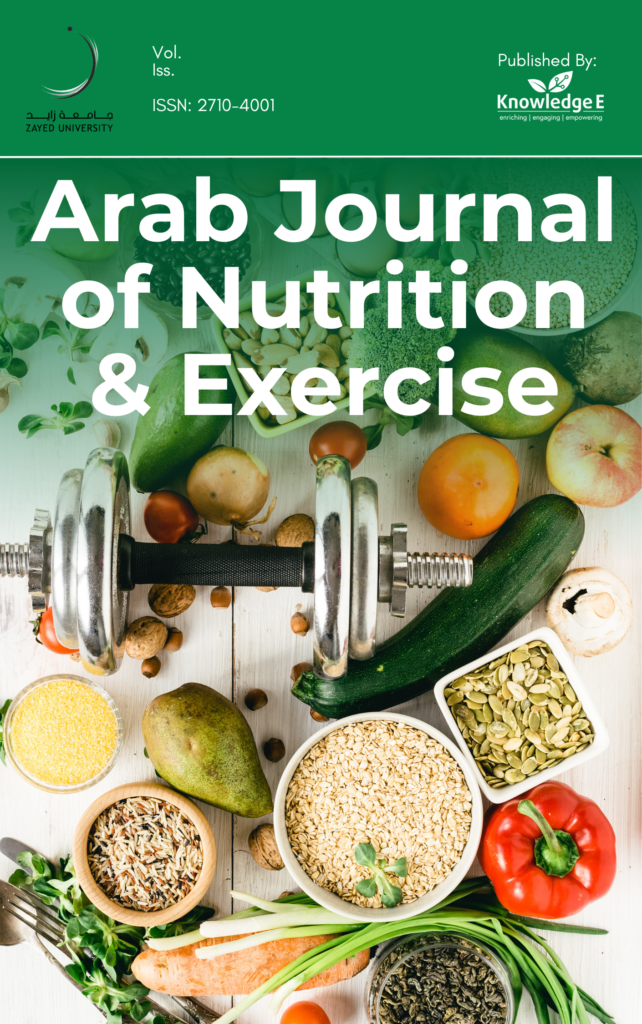
Arab Journal of Nutrition and Exercise
ISSN: 2518-6590
Groundbreaking research on nutrition, physical activity, and public health from across the Arab world.
Effect of Soy Milk and Mung Bean Porridge on Serum Triglycerides among Postmen-opausal Women
Published date: May 01 2019
Journal Title: Arab Journal of Nutrition and Exercise
Issue title: AJNE: Vol 4, No 1 (2019)
Pages: 11-17
Authors:
Abstract:
Aim: This study aimed to analyze the effect of soy milk and mung bean porridge on serum triglycerides among postmenopausal women. Methods: This was an experimental study using pretest and posttest with control group. Subjects of this study were 30 postmenopausal women aged 45-75 in Serengan District, Surakarta. Subjects were divided into control group (n = 10), soy milk group (n = 10) and combination of soy milk and mung bean porridge group (n =10). The soy milk and mung bean porridge provided were 240 ml and 180 ml per day per person, respectively. The study was carried out for 4 weeks from December 2018 to January
2019. The collected data were analyzed with paired t-test and Wilcoxon test.
Results: There was a slight decrease in serum triglycerides level in all groups, but it was not statistically
significant (p > 0,05).
Conclusions: Although soy milk and mung bean porridge contain many antihypertriglyceridemic nutrients, there is no significant effect on serum triglycerides among postmenopausal women. Further study with longer duration and more sample size is needed.
References:
[1] Arca, M., Borghi, C., Pontremoli, R., et al. (2017). Hypertriglyceridemia and Omega-3 Fatty Acids: Their Often Overlooked Role in Cardiovascular Disease Prevention. Nutrition, Metabolism and Cardiovascular Diseases, vol. 28, no. 3, pp. 197-205. DOI: 10.1016/j.numecd.2017.11.001
[2] Berglund, L., Brunzell, J. D., Goldberg, A. C., et al. (2012). Evaluation and Treatment of Hypertriglyceridemia: An Endocrine Society Clinical Practice Guideline. The Journal of Clinical Endocrinology and Metabolism, vol. 97, no. 9, pp. 2969-2989. DOI: 10.1210/jc.2011-3213
[3] Clifton, P. M., Mano, M., Duchateau, G. S. M. J., et al. (2008). Dose-response Effects of Different Plant Sterol Sources in Fat Spreads on Serum Lipids and C-reactive Protein and on the Kinetic Behavior of Serum Plant Sterols. European Journal of Clinical Nutrition, vol. 62, no. 8, pp. 968-997. DOI: 10.1038/sj.ejcn.1602814
[4] Fitrianti, D. Y., and Marthandaru, D. (2016). Effect of Soy Milk and Ginger on Total Cholesterol among Women. Jurnal Gizi Indonesia, vol. 4, no. 2, pp. 89-95. DOI: 10.14710/jgi.4.2.89-95
[5] Ganesan, K., and Xu, B. A. (2018). Critical Review on Phytochemical Profile and Health Promoting Effects of Mung Bean (Vigna radiata). Food Science and Human Wellness, vol. 7, no. 1, pp. 11-33. DOI:
10.1016/j.fshw.2017.11.002
[6] Higgins, J. (2014). Resistant Starch and Energy Balance: Impact on Weight Loss and Maintenance. Critical Reviews in Food Science and Nutrition, vol. 54, no. 9, pp. 1158-1166. DOI: 10.1080/10408398.2011.629352
[7] Johnson, R. K., Appel, L. J., Brands, M., et al. (2009). Dietary Sugars Intake and Cardiovascular Health:
a scientific statement from the American Heart Association. Circulation, vol. 120, no. 11, pp. 1011-1020. DOI: 10.1161/CIRCULATIONAHA.109.192627
[8] Kang, I. H., Chi, S. J., Ha, T. J., et al. (2015). Effects of Mung Bean (Vigna radiata L.) Ethanol Extracts Decrease Proinflammator Cytokine-Induced Lipogenesis in the KK-Ay Diabese Mouse Model. Journal of Medicinal Food, vol. 18, no. 8, pp. 841-849. DOI: 10.1089/jmf.2014.3364
[9] Kang, J., Badger, T. M., Ronis, M. J. J., et al. (2010). Non-isoflavone Phytochemicals in Soy and Their Health Effects. Journal of Agricultural and Food Chemistry, vol. 58, no. 14, pp. 8119-8133. DOI:
10.1021/jf100901b
[10] Keshavarz, S. A., Nourieh, Z., Attar, M. J. H., et al. (2012). Effect of Soy Milk Consumption on Waist Circumference and Cardiovascular Risks among Overweight and Obese Female Adults. International
Journal of Preventive Medicine, vol. 3, no. 11, pp. 798-805.
[11] Kim, D. K., Jeong, S. C., Gorinstein, S., et al. (2012). Total Polyphenols:Antioxidant and Antiproliferative
Activities of Different Extracts in Mungbean Seeds and Sprouts. Plant Foods for Human Nutrition, vol.
67, no. 1, pp. 71-75. DOI: 10.1007/s11130-011-0273-x
[12] Koda, M., Kitamura, I., Okura, T., et al. (2016). The Associations Between Smoking Habits and Serum
Triglyceride or Hemoglobin A1c Levels Differ According to Visceral Fat Accumulation. Journal of
Epidemiology, vol. 6, no. 4, pp. 208-215. DOI: 10.2188/jea.JE20150086
[13] Li, H., Cao, D., Yi, J., et al. (2012). Identification of the Flavonoids in Mungbean (Phaseolus radiatus
L) Soup and Their Antioxidant Activities. Food Chemistry, vol. 135, no. 4, pp. 2942-2946. DOI:
10.1016/j.foodchem.2012.07.048
[14] Lin, C., Chang, Y., Chien, S., et al. (2018). Epidemiology of Dyslipidemia in the Asia Pacific Region.
International Journal of Gerontology, vol. 12, no. 2, pp. 2-6. DOI: https://doi.org/10.1016/j.ijge.2018.02.
010
[15] Manafa, P. O., Aguiyi, N. C., Onyenekwe, C. C., et al. (2015). Comparative Assessment of Lipid Profile in
Pre-menopausal dan Menopausal Women in Nnewi Nigeria. European Scientific Journal, vol. 11, no. 3,
pp. 1857-1881.
[16] Marelli, M., Conforti, F., Araniti, F., et al. (2016). Effects of Saponins on Lipid Metabolism: A Review
of Potential Health Benefits in the Treatment of Obesity. Molecules, vol. 21, no. 10, pp. E1404. DOI: 10.3390/molecules21101404
[17] Ministry of Health of Indonesia. (2013). National Baseline Health Research. Badan Penelitian dan
Pengembangan Kesehatan, Jakarta.
[18] Murti B. (2016). Principal and Methods of Epidemiological Study. 4